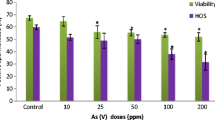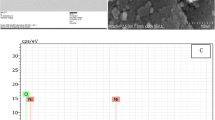Abstract
1,4-Dinitrobenzene (1,4-DNB) is a synthetic compound used in explosives, dyes, organic chemicals and the plastic industry. Oral and dermal exposure is a likely route for industrial workers and people living near ammunition plants. This study investigated the effect of 1,4-DNB on testicular and spermatozoan antioxidant systems as well as sperm characteristics of Wistar rats. Oral exposure of male Wistar rats to 50 or 75 mg/kg, or dermal exposure to 1000 or 2000 mg/kg, of 1,4-DNB for 14 days increased spermic and testicular hydrogen peroxide and lipid peroxidation levels accompanied by decreased activities of enzymic antioxidants. Exposure to 1,4-DNB also resulted in decrease in body weight gain, reduced testicular and epididymal weights, epididymal degeneration, decrease in sperm quantity and quality, and mild congestion of interstitial vessels and edema in the testes. These results reveal that individuals unduly exposed to 1,4-DNB risk induction of oxidative stress in the epididymis and testis, and associated reproductive deficits.
Similar content being viewed by others
References
Peltola, V., Maentylae, E., Huhtaniemi, I. & Ahotupa, M. Lipid peroxidation and antioxidant enzyme activities in the rat testis after cigarette smoke inhalation or administration of polychlorinated biphenyls or polychlorinated naphthalenes. J. Androl. 15, 353–353 (1994).
Quinn, P. & Payne, A. Oxygen-mediated damage of microsomal cytochrome P-450 enzymes in cultured leydig cells. Role in steroidogenic desensitization. J. Biol. Chem. 259, 4130–4135 (1984).
Chen, H. et al. Vitamin E, aging and Leydig cell steroidogenesis. Exp. Gerontol. 40, 728–736 (2005).
Agarwal, A. et al. Reactive oxygen species as an independent marker of male factor infertility. Fertil. Steril. 86, 878–885 (2006).
Khosrowbeygi, A. & Zarghami, N. Levels of oxidative stress biomarkers in seminal plasma and their relationship with seminal parameters. BMC Clin. Pathol. 7, 1 (2007).
Agarwal, A. et al. Role of oxidative stress in pathogenesis of varicocele and infertility. Urology 73, 461–469 (2009).
Wiser, H. J., Sandlow, J. & Köhler, T. S. in Male Infertility (Springer, New York, 2012).
Tremellen, K. Oxidative stress and male infertility -a clinical perspective. Hum. Reprod. 14, 243–258 (2008).
Shekarriz, M., DeWire, D., Thomas Jr, A. J. & Agarwal, A. A method of human semen centrifugation to minimize the iatrogenic sperm injuries caused by reactive oxygen species. Eur. Urol. 28, 31–31 (1995).
Shekarriz, M., Thomas, A. J. & Agarwal, A. Incidence and level of seminal reactive oxygen species in normal men. Urology 45, 103–107 (1995).
Blackburn, D. M., Gray, A. J., Lloyd, S. C., Sheard, C. M. & Foster, P. M. A comparison of the effects of the three isomers of dinitrobenzene on the testis in the rat. Toxicol. Appl. Pharm. 92, 54–64 (1988).
Reddy, T. et al. Separation and quantitation of nitrobenzenes and their reduction products nitroanilines and phenylenediamines by reversed-phase high-performance liquid chromatography. J. Chromatogr. A 655, 331–335 (1993).
Jenkins, T. F. & Grant, C. L. Comparison of extraction techniques for munitions residues in soil. Anal. Chem. 59, 1326–1331 (1987).
Sajan, M., Reddy, G. & Kulkarni, A. P. In vitro inhibition of mammalian glutathione transferases by selected nitrobenzenes. Int. J. Toxicol. 19, 285–292 (2000).
Brown, C. D., Forman, C. L., McEuen, S. F. & Miller, M. G. Metabolism and testicular toxicity of 1, 3-dinitrobenzene in rats of different ages. Toxicol. Sci. 23, 439–446 (1994).
Vásquez, G. B., Reddy, G., Gilliland, G. L. & Stevens, W. J. Dinitrobenzene induces methemoglobin formation from deoxyhemoglobin in vitro. Chem. Biol. Interact. 96, 157–171 (1995).
Chen, Y., Xu, J., Li, Y. & Han, X. Decline of sperm quality and testicular function in male mice during chronic low-dose exposure to microcystin-LR. Reprod. Toxicol. 31, 551–557 (2011).
Pigeolet, E. et al. Glutathione peroxidase, superoxide dismutase, and catalase inactivation by peroxides and oxygen derived free radicals. Mech. Ageing Dev. 51, 283–297 (1990).
Rasyidah, T., Suhana, S., Nur-Hidayah, H., Kaswandi, M. & Noah, R. Evaluation of antioxidant activity of Zingiber officinale (ginger) on formalin-induced testicular toxicity in rats. JOMB 3 (2014).
Jeulin, C., Soufir, J., Weber, P., Laval-Martin, D. & Calvayrac, R. Catalase activity in human spermatozoa and seminal plasma. Gamete Res. 24, 185–196 (1989).
de Lamirande, E. & Gagnon, C. Capacitation-associated production of superoxide anion by human spermatozoa. Free Radic. Biol. Med. 18, 487–495 (1995).
Maiti, S. & Chatterjee, A. K. Differential response of cellular antioxidant mechanism of liver and kidney to arsenic exposure and its relation to dietary protein deficiency. Environ. Toxicol. Pharmacol. 8, 227–235 (2000).
Godic, A., Poljšak, B., Adamic, M. & Dahmane, R. The role of antioxidants in skin cancer prevention and treatment. Oxid. Med. Cell. Longev 2014, 1–6 (2014).
Pisoschi, A. M. & Pop, A. The role of antioxidants in the chemistry of oxidative stress: A review. Eur. J. Med. Chem. 97, 55–74 (2015).
Baker, H. G., Brindle, J., Irvine, D. S. & Aitken, R. J. Protective effect of antioxidants on the impairment of sperm motility by activated polymorphonuclear leukocytes. Fertil. Steril. 65, 411–419 (1996).
Lushchak, V. I. Glutathione homeostasis and functions: potential targets for medical interventions. J. Amino Acids 2012, 1–26 (2012).
Lenzi, A. et al. Andrology: Glutathione treatment of dyspermia: effect on the lipoperoxidation process. Hum. Reprod. 9, 2044–2050 (1994).
Siems, W. et al. Metabolism of 4-hydroxy-2-nonenal in human polymorphonuclear leukocytes. Arch. Biochem. Biophys. 503, 248–252 (2010).
Dohle, G., Smit, M. & Weber, R. Androgens and male fertility. World J. Urol. 21, 341–345 (2003).
Li, Y., Sheng, J., Sha, J. & Han, X. The toxic effects of microcystin-LR on the reproductive system of male rats in vivo and in vitro. Reprod. Toxicol. 26, 239–245 (2008).
Biswas, N. M., Gupta, R. S., Chattopadhyay, A., Choudhury, G. R. & Sarkar, M. Effect of atenolol on cadmiuminduced testicular toxicity in male rats. Reprod. Toxicol. 15, 699–704 (2001).
Sarkar, M., Chaudhuri, G. R., Chattopadhyay, A. & Biswas, N. M. Effect of sodium arsenite on spermatogenesis, plasma gonadotrophins and testosterone in rats. Asian J. Androl. 5, 27–32 (2003).
Aitken, R. J. Free radicals, lipid peroxidation and sperm function. Reprod. Fertil. Dev. 7, 659–668 (1995).
Griveau, J., Dumont, E., Renard, P., Callegari, J. & Le Lannou, D. Reactive oxygen species, lipid peroxidation and enzymatic defence systems in human spermatozoa. J. Reprod. Fertil. 103, 17–26 (1995).
Vernet, P., Aitken, R. & Drevet, J. Antioxidant strategies in the epididymis. Mol. Cell. Endocrinol. 216, 31–39 (2004).
Sanocka, D. & Kurpisz, M. Reactive oxygen species and sperm cells. Reprod. Biol. Endocrinol. 2, 1 (2004).
Henkel, R. The impact of oxidants on sperm function. Andrologia 37, 205–206 (2005).
Ramya, T., Misro, M. M., Sinha, D. & Nandan, D. Sperm function and seminal oxidative stress as tools to identify sperm pathologies in infertile men. Fertil. Steril. 93, 297–300 (2010).
Dixon, W. The up-and-down method for small samples. J. Amer. Statist. Assoc. 60, 967–978 (1965).
Dixon, W. Staircase bioassay: the up-and-down method. Neurosci. Biobehav. Rev. 15, 47–50 (1991).
Dixon, W. J. & Mood, A. M. A method for obtaining and analyzing sensitivity data. JASA 43, 109–126 (1948).
Dixon, W. in Design and Analysis of Quantal Dose-Response Experiments (with Emphasis on Staircase Designs) (Dixon Statistical Associates, Los Angeles CA, USA, 1991).
Aebi, H. Catalase in vitro. Method Enzymol. 105, 121–126 (1984).
Gornall, A. G., Bardawill, C. J. & David, M. M. Determination of serum proteins by means of the biuret reaction. J. Biol. Chem. 177, 751–766 (1949).
Jollow, D., Mitchell, J., Zampaglione, N. A. & Gillette, J. Bromobenzene-induced liver necrosis. Protective role of glutathione and evidence for 3, 4-bromobenzene oxide as the hepatotoxic metabolite. Pharmacology 11, 151–169 (1974).
Misra, H. P. & Fridovich, I. The role of superoxide anion in the autoxidation of epinephrine and a simple assay for superoxide dismutase. J. Biol. Chem. 247, 3170–3175 (1972).
Wolff, S. P. Ferrous ion oxidation in presence of ferric ion indicator xylenol orange for measurement of hydroperoxides. Method Enzymol. 233, 182–189 (1994).
Buege, J. A. & Aust, S. D. [30] Microsomal lipid peroxidation. Method Enzymol. 52, 302–310 (1978).
Zemjanis, R. Diagnostic and therapeutic techniques in animal reproduction. Diagnostic and therapeutic techniques in animal reproduction (1962).
Pant, N. & Srivastava, S. Testicular and spermatotoxic effects of quinalphos in rats. J. Appl. Toxicol. 23, 271–274 (2003).
Joyce, K. L., Porcelli, J. & Cooke, P. S. Neonatal goitrogen treatment increases adult testis size and sperm production in the mouse. J. Androl. 14, 448–455 (1993).
Robb, G., Amann, R. & Killian, G. Daily sperm production and epididymal sperm reserves of pubertal and adult rats. J. Reprod. Fertil. 54, 103–107 (1978).
Wells, M. & Awa, O. New technique for assessing acrosomal characteristics of spermatozoa. J. Dairy Sci. 53, 227–232 (1970).
Avwioro, G. Histochemical uses of haematoxylin -a review. JPCS 1, 24–34 (2011).
Author information
Authors and Affiliations
Corresponding author
Rights and permissions
About this article
Cite this article
Sangodele, J.O., Olaleye, M.T., Monsees, T.K. et al. Redox status and sperm characteristics in 1,4-dinitrobenzene-induced reproductive toxicity in Wistar rats. Toxicol. Environ. Health Sci. 9, 12–22 (2017). https://doi.org/10.1007/s13530-017-0298-0
Received:
Revised:
Accepted:
Published:
Issue Date:
DOI: https://doi.org/10.1007/s13530-017-0298-0




